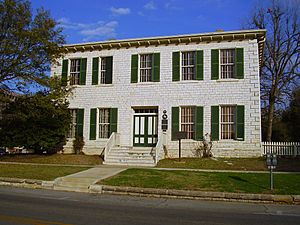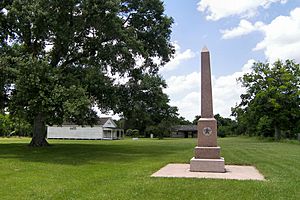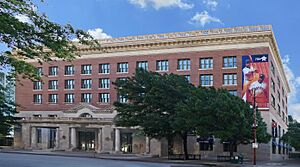Texas Historical Commission facts for kids

Texas Historical Commission seal
|
|
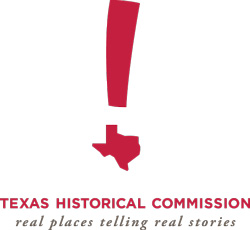
Texas Historical Commission logo
|
|
| Agency overview | |
|---|---|
| Formed | 1953 |
| Headquarters | Austin, Texas, United States |
| Employees | 175 |
The Texas Historical Commission (THC) is a special group in Texas that works to protect and share the state's history. It helps keep old buildings, places, and stories safe for everyone to learn from. The THC also manages the National Register of Historic Places for important sites in Texas.
This commission finds and marks special places called Recorded Texas Historic Landmarks (RTHL). They put up Official Texas Historical Marker (OTHM) signs with information about these spots. The THC also identifies important old burial grounds and archeological sites. They publish a magazine called The Medallion with news about history projects and places to visit. You can also find over 300,000 historical records on their online Texas Historic Sites Atlas.
The main offices of the commission are in downtown Austin. These offices are located in several historic buildings. These include the Carrington-Covert House, Luther Hall, Gethsemane Lutheran Church, the Elrose Building, and the Christianson-Leberman Building.
Contents
History of the Commission
The Texas Historical Commission started in 1953. Back then, it was called the Texas State Historical Survey Committee. Its job was to look after historical programs in the state. Later, the state government gave the agency more power. They expanded its role in protecting history and teaching people about it. That's when its name officially changed to the Texas Historical Commission (THC). In 2007, the THC also took over managing 20 state historic sites. These sites were moved from the Texas Parks and Wildlife Department.
Who Works at the Commission?
Today, about 350 people work for the Texas Historical Commission. The commission is led by 15 members. The governor chooses these members, and the state senate approves them. They serve for six years. All members must be Texas citizens and represent different parts of the state.
The THC also hires experts in many areas. These include people who study old buildings, ancient sites, and how towns grow. They also have historians and people who work in tourism. These experts help Texans and groups protect Texas's important buildings, archeological finds, and cultural places.
The agency has different teams that manage its programs. Some of these teams are:
- Administration (managing the agency)
- Archeology (studying ancient sites)
- Architecture (working with historic buildings)
- Community Heritage Development (helping local communities)
- Historic Sites (managing state historic places)
- History Programs (creating history projects)
- Public Information and Education (sharing information)
- Staff Services (supporting the staff)
There are also several groups that work with the Texas Historical Commission. These include boards that review historical sites and advise on preservation.
Texas Heritage Trails Program
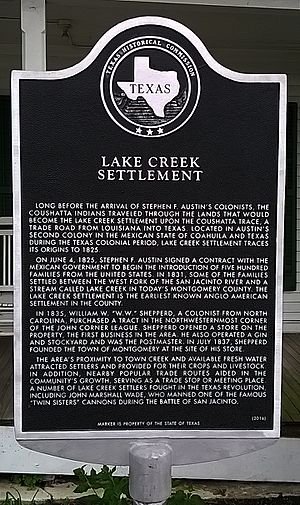
The Texas Historical Commission runs a program called the Texas Heritage Trails. This program helps people explore Texas history through special driving routes. These routes were first set up in 1968 for the World's fair in San Antonio, Texas, called HemisFair '68. After the fair, people mostly forgot about them.
In 1998, the Texas Historical Commission brought these trails back to life. They started with the Texas Forts Trail. The main goal of this program is to encourage people to visit historical places. It also helps protect these important sites.
The THC has divided Texas into 10 heritage regions:
- Texas Brazos Trail
- Texas Forest Trail
- Texas Forts Trail
- Texas Hill Country Trail
- Texas Independence Trail
- Texas Lakes Trail
- Texas Mountain Trail
- Texas Pecos Trail
- Texas Plains Trail
- Texas Tropical Trail
In 2005, the Heritage Trails Program won a special award. It received the Preserve America Presidential Award. This award recognized its great work in preserving and using America's historical treasures.
State Historic Sites
The Texas Historical Commission takes care of 41 state historic sites across Texas. These unique places help us remember the past. They also help us understand what it means to be a Texan. These sites include ancient American Indian places and old frontier forts. They also feature homes of important leaders and everyday people. Visiting these sites helps people learn about history.
For example, Fort Griffin is one of these sites. It is home to the official State of Texas Longhorn Herd.
Historical Markers

People can apply for official historical markers through their local county historical groups. These markers come in different types and sizes. They can be for cemeteries, buildings, or specific historical topics. Their main purpose is to teach the public about important historical events or places. An application must meet certain rules to be approved by the THC.
In November 2006, the Texas Historical Commission updated its marker program. Some of the big changes included:
- All applications now had to be sent online.
- There was a new yearly deadline for applications.
- People had to pay a fee to apply.
- The way the words on the markers were written also changed.
As of 2007, there were over 13,000 Official Texas Historical Markers across the state. Texas has more historical markers than any other state in the United States.
Recorded Texas Historic Landmark
A Recorded Texas Historic Landmark is the highest honor given by the Texas Historical Commission. It is for very important historical buildings in Texas.
State Antiquities Landmark
The THC can also name certain places as State Antiquities Landmarks. These places cannot be on federal land. They can be one of two types:
- Historic buildings that are also listed on the National Register of Historic Places. These places are usually well-known to the public.
- Archeological sites. These sites might not be on the National Register. Their exact locations are kept secret from the public. This is to stop people from damaging them.
Being named a State Antiquities Landmark does not mean a building or site can never be changed. Instead, it means that any changes need a special permit. The THC reviews these changes to make sure history is protected.
Headquarters Complex
The main offices of the commission are in downtown Austin. This group of buildings includes the Carrington-Covert House at 1511 Colorado Street. It also has Luther Hall, Gethsemane Lutheran Church, the Elrose Building, and the Christianson-Leberman Building.
The Carrington-Covert House became the agency's main office in 1971. Gethsemane Lutheran Church was fixed up in 1970 and 1971 to also serve as offices for the agency.
Friends of the Texas Historical Commission
The Friends of the Texas Historical Commission (FTHC) is a group that helps raise money. It started in 1996. Their goal is to get private donations to support the THC's work. This helps the THC find, protect, and save Texas history. Their efforts create a lasting legacy for future generations. The FTHC gets money to support THC projects that are not covered by the state budget. Even though it's called "Friends," it's not a group you can join as a member.
Over the last twenty years, the FTHC has helped raise more than $10 million. This money has supported many important projects. These include digging up the 17th-century La Belle shipwreck. They also helped with the Fort St. Louis excavation. Other projects include the Red River War Battle Sites Project and programs about Texas in the Civil War and World War II. They also helped restore the Fulton Mansion and 23 historic Texas flags.
See also
 In Spanish: Comisión Histórica de Texas para niños
In Spanish: Comisión Histórica de Texas para niños
- List of National Historic Landmarks in Texas
- National Register of Historic Places listings in Texas
- T. R. Fehrenbach Award
- List of historical societies in Texas


